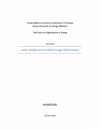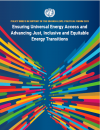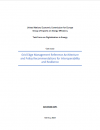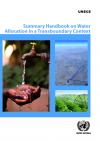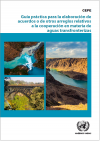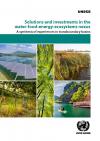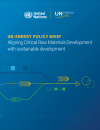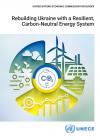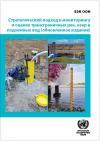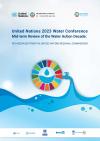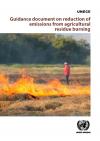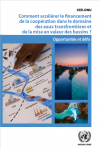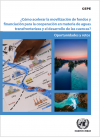Publications
Displaying Results 1 - 20 of 1067
- English
Digitalization is gaining more and more attention as a way to support and complement the energy transition process. Digitalization entails the use of digital technologies for existing processes, as it helps address existing challenges in new ways.
While using an integrated energy system with intelligent connected devices has many advantages, it also causes challenges. One of these challenges is
- English
The sixth compilation of the SDG 7 Policy Briefs, titled "Ensuring Universal Energy Access and Advancing Just, Inclusive and Equitable Energy Transitions," prepared by the SDG 7 Technical Advisory Group (SDG7 TAG), in support of the review of the SDGs at the United Nations High-Level Political Forum 2023.
- English
This UN-Energy Policy Brief was prepared in support of the SDG7 review at the High-level Political Forum 2023 in line with the UN-Energy Plan of Action Towards 2025. The Plan outlines UN-Energy’s contributions towards the implementation of the Global Action Plan for Accelerated SDG 7 Action presented by the UN Secretary-General as an outcome of the UN High-level Dialogue on Energy in 2021. The
- English
This case study addresses the challenge of distributed energy resources integration to support grid resilience, identifying key infrastructure requirements, assessing policy developments and deriving recommendations. The underlying premise of this case study asserts that whilst the energy sector is making advances towards decarbonization, decentralization and digitalization, the increasing share
- English
Hydrogen is an energy carrier that can decarbonize economies and promote sustainable economic growth and system resilience. Although many low-emission hydrogen projects have been announced over the past two years, a mere 4% of them have reached a final investment decision. This indicates that achieving the scale and pace of hydrogen deployment requires more decisive actions from policymakers and
- English
This Summary Handbook on Water Allocation in a Transboundary Context (Summary Handbook) contains the key information from the Handbook on Water Allocation in a Transboundary Context (Handbook) adopted by the 9th Meeting of the Parties (MOP9) to the Water Convention in 2021, covering the global practice of transboundary water allocation. It seeks to be a shorter and targeted practical resource for
- Español
La elaboración de arreglos transfronterizos y el establecimiento de órganos conjuntos es una obligación clave para las Partes ribereñas del Convenio sobre la Protección y Utilización de los Cursos de Agua Transfronterizos y de los Lagos Internacionales (“Convenio del Agua de 1992”). Sin embargo, la presentación de informes sobre el Convenio del Agua de 1992 y sobre el indicador 6.5.2 de los ODS,
- Español
Los recursos hídricos y los ecosistemas sustentan el desarrollo socioeconómico en la energía y la agricultura, así como en la industria, el turismo, la navegación y otros sectores. Sin embargo, estos desarrollos también ejercen una presión significativa sobre el medio ambiente, con impactos sobre la disponibilidad y la calidad del agua. Abordar los problemas relacionados con el agua y el medio
- Français
La Convention sur la protection et l’utilisation des cours d’eau transfrontières et des lacs internationaux (Convention sur l’eau), dont le secrétariat est hébergé par la Commission économique des Nations Unies pour l’Europe (CEE-ONU), prescrit aux parties d’élaborer et de mettre en place des programmes communs de surveillance des eaux transfrontières, de procéder à des évaluations communes ou
- Pусский
Более 60% мировых запасов пресной воды сосредоточено в водных бассейнах, простирающихся по территории двух или более прибрежных государств. Устойчивое совместное управление этими трансграничными водными ресурсами имеет решающее значение для обеспечения доступа к водным ресурсам, устойчивого развития, региональной стабильности и мира. Однако многие страны и бассейны сталкиваются с трудностями при
- Français
Supporting transboundary water cooperation and the sustainable management of shared water resources
The Water Convention, which celebrated its 30th anniversary in 2022, is a key legal and intergovernmental framework for promoting transboundary water cooperation and sustainable management of shared water resources that has proven its effectiveness over the past 30 years. The Convention, which
- العربية
إن وضع اتفاقات عابرة للحدود وإنشاء هيئات مشتركة هي من االلتزامات األساسية التي تقع على عاتق
األطراف المتشاطئة التفاقية حماية واستخدام المجاري المائية العابرة للحدود والبحيرات الدولية (“اتفاقية
1992 ”). ومع ذلك، فإن اإلبالغ عن التقدم المحرز في تحقيق اتفاقية المياه لعام1992 المياه لعام
من أهداف التنمية المستدامة، الذي يقيس نسبة مناطق أحواض المياه العابرة للحدود 6-5-2 والمؤشر
التي تربطها ترتيبات
- English
Transitioning towards a clean energy future is a core element of global efforts to achieve the climate goals of the Paris Agreement. The technologies underpinning that transition to low-carbon energy systems – such as wind, solar photovoltaic (PV), electric motors and batteries – are more minerals-intensive than fossil fuel-based technologies, however. As a result, the energy transition implies a
- English
In view of their high untapped potential, bioenergy, hydro, solar and wind generation could constitute the building blocks of Ukraine’s future energy system, contributing up to nearly 80% of total energy generation by 2050. Provided key strategies and investments are put in place, and complemented by nuclear, renewables could propel Ukraine towards a carbon-neutral future. These are the main
- Pусский
В соответствии с Конвенцией по охране и использованию трансграничных водотоков и международных озер (Конвенция по трансграничным водам), секретариатом которой является Европейская экономическая комиссия
Организации Объединенных Наций (ЕЭК ООН), Стороны должны разрабатывать и осуществлять совместные программы мониторинга состояния трансграничных вод, осуществлять совместно или в координации друг с
- English
The booklet summarizes input from the five United Nations Regional Commissions and UN-Water regional discussion groups to the United Nations 2023 Water Conference. It provides a snapshot of the agreed input from the regional discussions to the global event, reflecting the diversity of views and experiences. It also showcases progress, opportunities and challenges identified in the five regions as
- English
Agricultural residue burning is a challenge in many countries in the ECE region, as well as at the global level. Substantial and clear evidence exists that fire use has negative impact on soil organic matter by reducing soil fertility and ultimately reducing yields. Moreover, the emissions generated by agricultural residue burning contribute to air pollution and are important drivers of climate
- Pусский
Более 60 процентов мировых запасов пресной воды сосредоточено в водных бассейнах, простирающихся по территории двух или более прибрежных государств. Устойчивое совместное управление этими трансграничными водными ресурсами имеет решающее значение для обеспечения доступа к водным ресурсам, устойчивого развития, региональной стабильности и мира.
Однако многие страны и бассейны сталкиваются с
- Français
Plus de 60 % des fleuves du monde sont partagés par deux ou plusieurs États riverains. La gestion durable et collaborative de ces ressources en eaux transfrontières est cruciale pour assurer l’accès à l’eau et le développement durable, ainsi que la paix et la stabilité au niveau régional.
De nombreux pays et bassins éprouvent pourtant des difficultés à trouver et mobiliser les ressources
- Español
Más del 60 % de los caudales de agua dulce mundial corresponden a aguas compartidas entre dos o más Estados ribereños. La gestión sostenible y cooperativa de esos recursos hídricos transfronterizos es crucial para el acceso al agua y el desarrollo sostenible, así como para la estabilidad y la paz regionales.
Sin embargo, muchos países y cuencas tienen dificultades para identificar y movilizar los


